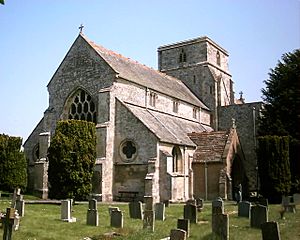Church of St Peter and St Paul, Heytesbury facts for kids
Quick facts for kids St Peter and St Paul, Heytesbury |
|
|---|---|
| Church of St Peter and St Paul | |
 |
|
| Lua error in Module:Location_map at line 420: attempt to index field 'wikibase' (a nil value). | |
| OS grid reference | ST925426 |
| Location | Heytesbury, Wiltshire |
| Country | England |
| Denomination | Anglican |
| History | |
| Status | Parish church |
| Architecture | |
| Functional status | Active |
| Years built | 13th century, restored 1864-7 |
| Administration | |
| Parish | Heytesbury with Tytherington and Knook |
| Deanery | Heytesbury |
| Archdeaconry | Sarum |
| Diocese | Salisbury |
| Province | Canterbury |
The Church of St Peter and St Paul, Heytesbury is a special church in Heytesbury, Wiltshire, England. It serves the local communities of Heytesbury, Tytherington, and Knook. For many years, from the 1100s until 1840, it was a collegiate church. This means it had a group of priests living and working together. Today, the church building is mostly from the 1200s. It is considered a very important historical building, listed as Grade I.
Contents
History of the Church
Early Beginnings
A church was first mentioned in Heytesbury in the Domesday Book of 1086. This was a very old record of England. Around 1115, King Henry I gave the church to Salisbury Cathedral. He also gave the church in Godalming, Surrey, and some land. This was done to create a special income source called a prebend for the cathedral.
Becoming a Collegiate Church
Soon after, the Heytesbury church became a collegiate church. This meant it had a group of priests, called canons, who lived and worked there. The main priest of this group was also a canon at Salisbury Cathedral.
Between 1150 and 1160, a bishop named Josceline set up four canons at Heytesbury. They received income from different places. This included money from tithes (a type of tax) from Tytherington and Horningsham. They also got income from the churches of Hill Deverill and Swallowcliffe. From about 1220, the Dean of Salisbury Cathedral also became the Dean of Heytesbury.
Most collegiate churches were closed in 1547 during the English Reformation. However, Heytesbury continued for a while longer. It was finally closed in 1840 by a new law.
Church Design and Inside Features
Building Through the Centuries
This large church is shaped like a cross, which is called cruciform. Most of it was built in the 1200s. However, one small part of an older wall, from the late 1100s, can still be seen.
The low tower, located where the cross shape meets, was finished in the 1300s. Later, in the mid-1400s, a row of windows high up on the walls, called a clerestory, was added.
Chapels and Bells
The south chapel was built around 1316 and is dedicated to St Catherine. In the north transept (one of the "arms" of the cross shape), Walter Hungerford started another chapel in 1421. A stone screen from the 1500s still stands there.
The church tower has six bells. The largest bell is from around 1460. Two other bells are from the 1600s, and two more are from the 1700s.
Victorian Restoration
The vestry (a room for priests) and the south porch were added in the 1800s. The church underwent a big restoration between 1864 and 1867. This work was led by an architect named William Butterfield.
During this restoration, the north and south aisles (side sections of the church) were rebuilt. Inside, a colorful marble font (for baptisms) was added. New pews (church benches) and a floor with colorful tiles were also installed. The beautiful stained glass windows were made by Alexander Gibbs.
Some people, like the art historian Pevsner, thought the restoration was a bit too much. He said the church looked better from far away than up close. However, he did praise the stained glass, calling it "good and characteristic."
The Organ
The church organ was first put in place in 1854. It was moved from St Mary's Church in Bermondsey, London. During Butterfield's restoration, the organ was taken down. It was then put back together in a new spot in 1867. New wooden fronts were added to its case.
In 1968, the church building was officially recognized as a Grade I listed building. This means it is a very important historical site.
The Church Parish
Local Communities Served
In the past, Heytesbury church also served other nearby chapels and churches. These included places like Tytherington, Knook, Hill Deverill, Horningsham, and even Swallowcliffe, which is about 10 miles (16 km) away.
In 1885, the churches of Heytesbury-with-Tytherington and Knook joined together. This union was confirmed again in 1970. Later, in 1976, the parishes of Sutton Veny and Norton Bavant were added.
Since 2000, the church has been part of the Upper Wylye Valley team of churches. As of August 2025, the main priest position for the team is empty. The Vicar position is also vacant, as the previous Vicar left in February 2024.
Church Records
Records of the parish, like baptism and marriage registers, exist from 1653. These important historical documents are kept at the Wiltshire and Swindon History Centre in Chippenham.
Services and Events
The group of churches holds a Eucharist service (also known as Communion) in at least two of its churches every Sunday. The current A Church Near You page shows that Communion is celebrated in Heytesbury on the first Sunday of each month.
A special evening service called Choral Evensong is held on the third Sunday of every month.

